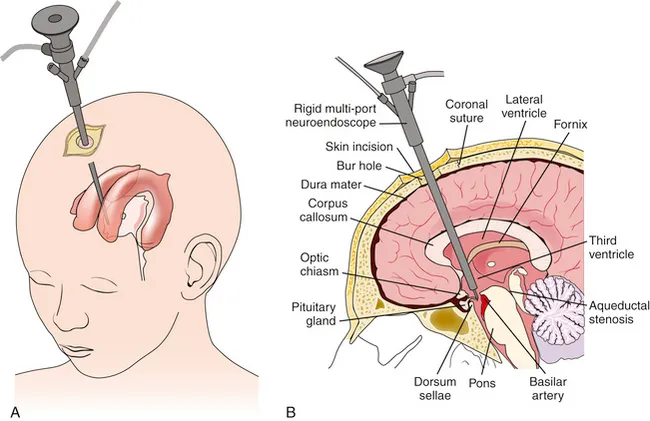Endoscopic Third Ventriculostomy (ETV)
Endoscopic Third Ventriculostomy (ETV)
Endoscopic Third Ventriculostomy (ETV) in Bangladesh – Advanced, Shunt-Free Hydrocephalus Treatment by Leading Pediatric Neurosurgeon Dr. Md. Nafaur Rahman
Endoscopic Third Ventriculostomy (ETV) is a modern, minimally invasive neurosurgical procedure used to treat obstructive (non-communicating) hydrocephalus without the need for lifelong shunt placement. In Bangladesh, the demand for safer, long-term solutions to childhood hydrocephalus is growing. Under the expert care of Dr. Md. Nafaur Rahman, a leading name in pediatric neurosurgery, ETV is now being successfully offered with excellent outcomes at both National Institute of Neurosciences & Hospital and the Bangladesh Paediatric Neurocare Centre.
What is Endoscopic Third Ventriculostomy (ETV)?
ETV is a neuroendoscopic procedure where a tiny hole is created in the floor of the third ventricle in the brain, allowing cerebrospinal fluid (CSF) to bypass the obstruction and flow freely to the brain’s natural absorption pathways. Unlike traditional Ventriculo-Peritoneal (VP) shunt surgery, ETV avoids the use of artificial devices and offers a more natural, long-term solution for specific types of hydrocephalus.
Who Needs ETV?
ETV is particularly beneficial in children and adults with:
Aqueductal stenosis (narrowing of the cerebral aqueduct)
Congenital obstructive hydrocephalus
Hydrocephalus due to posterior fossa tumors
Shunt malfunction or failure, where a natural flow path can be restored
In the Bangladesh context, ETV is a significant step forward in managing shunt-related complications, reducing long-term dependency, and improving the quality of life for pediatric patients.
Why ETV Over Traditional Shunt Surgery?
No foreign device implanted inside the body
Lower risk of infection and mechanical failure
Reduces long-term follow-ups and surgeries
More physiological CSF flow pattern
Ideal for patients in remote areas of Bangladesh with limited access to emergency neurosurgical services
ETV Procedure: Technology and Expertise in Bangladesh
At the National Institute of Neurosciences & Hospital and Bangladesh Paediatric Neurocare Centre, ETV is performed using state-of-the-art neuroendoscopic systems. The procedure is performed under general anesthesia through a small keyhole opening in the skull. With high-resolution intraoperative endoscopic visualization, Dr. Md. Nafaur Rahman ensures maximum precision and minimal risk to delicate brain structures.
Post-ETV Follow-up and Recovery
Most patients recover well and are discharged within a few days. Recovery protocols include:
Imaging follow-up (MRI or CT) to confirm ETV patency
Neurological assessments to monitor symptom resolution
Parental education for pediatric patients
Long-term surveillance to detect potential failure signs early
ETV Success Rate in Bangladesh – What to Expect?
When performed by skilled pediatric neurosurgeons like Dr. Md. Nafaur Rahman, the ETV success rate in obstructive hydrocephalus cases can exceed 70–90%, especially in older children and adults. Factors such as patient age, etiology of hydrocephalus, and CSF dynamics are carefully evaluated before selecting ETV as the treatment of choice.
Why Choose Dr. Md. Nafaur Rahman for ETV Surgery in Bangladesh?
👨⚕️ Highly Trained in Pediatric Neuroendoscopy
📍 Assistant Professor, Pediatric Neurosurgery, National Institute of Neurosciences & Hospital
🏥 Chief Consultant, Bangladesh Paediatric Neurocare Centre
🔬 Uses advanced neuroendoscopic technology for precision
👶 Specialized in infant and child hydrocephalus care
🧠 Trusted by parents across Bangladesh for safe, ethical, and evidence-based neurosurgical solutions
Regions Served
Dr. Nafaur’s expertise in ETV is available to patients from Dhaka, Chattogram, Khulna, Rajshahi, Sylhet, Barisal, Mymensingh, and all other divisions of Bangladesh. International patients from neighboring countries can also access consultations and treatment with advance booking.
Contact for ETV Consultation in Bangladesh
If you or your child is facing hydrocephalus or suffering from shunt-related complications, ETV could be the safe, long-lasting solution you are looking for.
📞 Dr. Md. Nafaur Rahman
Assistant Professor, Department of Pediatric Neurosurgery
National Institute of Neurosciences & Hospital, Dhaka
Chief Consultant, Bangladesh Paediatric Neurocare Centre
🌐 Website: www.neurosurgeonnafaur.com
📧 Email: info@neurosurgeonnafaur.com
☎ Hotline: +8801912989182 , +8801607033535
🕒 Appointment Schedule Available Online








